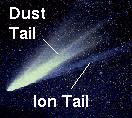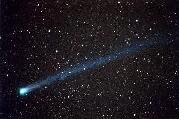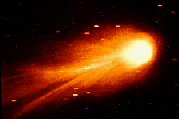Comets
Comets are small bodies made out of dust and ices ("dirty snowballs").
The term "comet" derives from the Greek aster kometes, which means
"long-haired star"---a reference to the tail. The following images show three
recent bright comets:
Comet West
(Ref),
Comet Hyakutake
(Ref), and
Comet Halley
(Ref)
.

Comet West (1976)
|

Comet Hyakutake (1996)
|

Comet Halley (1984)
|
The Nature of Comets
Once
thought to be phenomena in our atmosphere, we have known since the observations
of Tycho Brahe that they are parts of the Solar System well beyond Earth's
atmosphere. Most are on long
elliptical orbits (perhaps parabolic in some cases)
that take them from the outer reaches of the
Solar System to the vicinity of the Sun. If they
come near the Sun they are heated and emit gases and dust that are swept by the
Solar Wind into the characteristic tail that consequently always points
away from the Sun.
Observation of Comets
Historically, comets
have been the subject of fear and foreboding because it was once thought that
their appearance foretold momentous events. Although a dozen or so comets pass
through the inner Solar System each year, comets easily visible to the naked
eye occur only every decade of so, on the average.
Comets are commonly named after
their discoverers, so they are a popular target of amateur and professional
observers. The characteristics that distinguish comets observationally are
that they move (slowly) with respect to the background stars from night to
night, and they have a fuzzy appearance, especially as they near the Sun.





